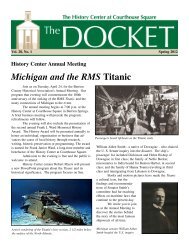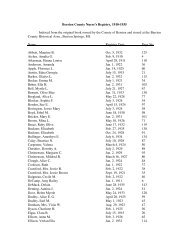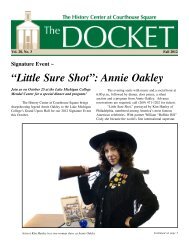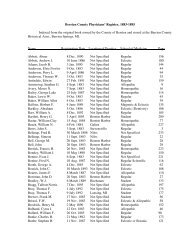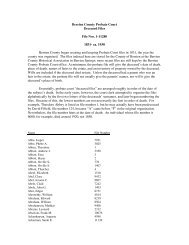2013 Program Flyer - Berrien County Historical Association
2013 Program Flyer - Berrien County Historical Association
2013 Program Flyer - Berrien County Historical Association
Create successful ePaper yourself
Turn your PDF publications into a flip-book with our unique Google optimized e-Paper software.
On-Site Tours & <strong>Program</strong>s<br />
Log Cabin Living. Grades K-3. A tour of the<br />
museum’s 1830 Murdock Log House centers on the<br />
lives of Michigan’s early settlers. Interpretation focuses<br />
on the roles of all the family members as they attempted<br />
to survive and prosper in frontier America.<br />
Museum Tour. All ages. Includes a tour of the<br />
historic 1839 <strong>Berrien</strong> <strong>County</strong> Courthouse, 1870<br />
Sheriff’s Residence, 1830 Log House, and museum<br />
exhibits. Includes an examination of the site’s role as a<br />
governmental center for the county.<br />
Mock Trials in the 1839 Courthouse Courtroom<br />
The Counterfeiting Trial of George Harlan, 1843.<br />
Grades 4-12. Students learn about America’s judicial<br />
system as they recreate the trial of George Harlan,<br />
accused of counterfeiting silver dollars. Students play<br />
the roles of judge, lawyers, witnesses and jurors in a trial<br />
moderated by the museum staff. A preparation packet<br />
sent in advance of the tour helps orient the students to<br />
their roles. Can include a general tour of the museum.<br />
Stop the Railroad! Grades 9-12. In this advanced<br />
civics lesson, students learn about the judicial system<br />
and public government. They recreate the 1880 civil<br />
case of a citizen suing to prevent the issuing of public<br />
bonds to build a privately-owned railroad. Should the<br />
taxpayers build the railroad their town needs, or should<br />
they refuse to pay Students play all the roles, aided by<br />
pre-tour preparation materials and a museum staff<br />
moderator. Can include a general tour of the museum.<br />
Springing into the 1830s, and Pioneer Harvest<br />
Days. Grades 3-8. Every spring and fall the entire<br />
Courthouse Square becomes a center of hands-on<br />
activities teaching about life in Michigan’s early settlement<br />
period. Activities and demonstrations vary from<br />
year-to-year, but typically include open-hearth cooking,<br />
blacksmithing, quill pen writing, early toys and games,<br />
dancing, corn shelling, and using a cross-cut saw.<br />
Living History Outreach <strong>Program</strong>s<br />
Bring the Museum to the Classroom!<br />
Voyageurs in New France. 4th grade to adult. In a oneman<br />
show as Jean-Paul DuVall, a French-Canadian fur trader<br />
in 1750, museum curator Bob Myers tells the story of life at<br />
the French post of Fort St. Joseph. The hazards and rewards<br />
of trade with Native Americans coms alive in this costumed<br />
portrayal.<br />
Hard Bread and Coffee: A<br />
Civil War Soldier’s Life. 4th<br />
grade to adult. In a portrayal<br />
of Cpl. Martin W. Stafford of<br />
Niles, a soldier in the 2nd<br />
Michigan Infantry, curator Bob<br />
Myers relates his experiences<br />
from Bull Run to Petersburg<br />
from the common soldier’s<br />
viewpoint.<br />
Life in 18th Century<br />
America. 4th grade to adult.<br />
(Call for fees)<br />
Colonial America comes alive when interpreters visit your<br />
school to present sessions on 18th century life. Choose up to<br />
five presentations, including flintlock muskets and soldiers’<br />
military drill; quill pen writing; colonial dance; women’s<br />
clothing; and men’s clothing.<br />
Letters from a Copperhead. High school to adult. Not<br />
all Northerners supported the Civil War or the Lincoln<br />
Administration. Anti-war Democrats, known as Copperheads,<br />
viewed Abraham Lincoln’s suppression of civil rights<br />
as a threat to the Constitution. The exchange of letters<br />
between one such Copperhead and his brother, Capt. Darius<br />
Brown of the 12th Michigan Infantry, come to life in a threecharacter<br />
dramatic reading.<br />
The Common Soldier in the American Revolution.<br />
Reproduction clothing and equipment, including flintlock<br />
muskets and cartridge boxes, are used to study the world of<br />
soldiers in the Revolutionary War. Women’s clothing,<br />
modeled by a volunteer from the audience, helps illustrate<br />
the social role of women in the 18th century.<br />
Slide/PowerPoint Presentations<br />
Adeline & Julia: Growing Up in Michigan and on the<br />
Kansas Frontier. Sisters Adeline and Julia Graham of<br />
<strong>Berrien</strong> Springs kept lively diaries of their youthful adventures<br />
- Adeline as a teenaged tomboy and Julia as a young<br />
woman homesteading in Kansas. Their diaries show<br />
Victorian women leaving their prescribed “women’s sphere”<br />
of life to engage in politics, business and homesteading.<br />
All Aboard! Railroads in<br />
<strong>Berrien</strong> <strong>County</strong>.<br />
Many rail lines served<br />
<strong>Berrien</strong> <strong>County</strong>. Their<br />
success or failure determined<br />
how the county appears<br />
today. Photographs illustrate<br />
the railroads’ contributions to transportation, industrial<br />
development, consumption of raw materials and the introduction<br />
of modern business practices.<br />
Benton Harbor: A <strong>Historical</strong> Review. One of <strong>Berrien</strong><br />
<strong>County</strong>’s youngest towns (founded in 1860), Benton Harbor<br />
saw explosive growth that turned it into a social, cultural and<br />
economic powerhouse. This illustrated program traces the<br />
city’s meteoric rise from transportation center to industrial<br />
city to its late 20th century decline.<br />
The Frozen Image: Photography in America. The<br />
invention of the daguerreotype in 1839 thrilled the world.<br />
Tintypes, ambrotypes, albumen prints and other forms of<br />
photography magically captured images of America and<br />
Americans. This program teaches the identification and<br />
preservation of different varieties of photographs.<br />
Gangsters in <strong>Berrien</strong> <strong>County</strong>. Southwest Michigan’s<br />
proximity to Chicago made it a natural retreat for the 1920s<br />
gangsters. Al Capone’s cronies frequented the area, owned<br />
homes here, and murdered a St. Joseph policeman. This<br />
illustrated program explores the history of the Gangster Era<br />
and identifies some of the local sites that still exist today.<br />
Greetings From Buchanan. Founded as a mill and factory<br />
town in 1842, Buchanan was headquarters to international<br />
manufacturing companies, including Clark Equipment.<br />
Photographs provide a visual tour of the city’s people,<br />
streets, parks and businesses.
Lost on the Lakes: Shipwrecks of <strong>Berrien</strong> <strong>County</strong>.<br />
From schooners to steamers,<br />
the remains of scores of<br />
ships litter the bottom of<br />
Lake Michigan off <strong>Berrien</strong><br />
<strong>County</strong>’s shore. Discover<br />
the dramatic history of these<br />
ships, the communities they<br />
served, and their tragic fates.<br />
The May Graham: Steamboats on the St. Joseph River.<br />
The sternwheeler May Graham operated from 1879 to<br />
1908, linking <strong>Berrien</strong> Springs with the harbor at St. Joseph.<br />
Take an engaging visual tour of the river aboard one of the<br />
last steamboats to ply its waters.<br />
Pioneers of the Sky. Discover the early history of flight<br />
from the experiments of Hiram Maxim and Clement Ader to<br />
Samuel Langley and the Wright Brothers. Find out how<br />
Augustus Herring of St. Joseph flew an airplane on Silver<br />
Beach - in 1898!<br />
<strong>Berrien</strong> Springs in Pictures. Founded in 1831, <strong>Berrien</strong><br />
Springs is one of southwest Michigan’s oldest communities.<br />
Photographs taken between 1870 and 1930 provide a<br />
travelogue of the town’s people, parks, and commercial and<br />
residential architecture.<br />
The Flag of Michigan. Why does our state flag bear the<br />
images of a moose and an<br />
elk What does the word<br />
“Tuebor” mean Find out<br />
about the fascinating and<br />
funny stories behind the<br />
symbolism of our familiar<br />
state banner.<br />
The Worst Colonel I Ever Saw: Francis Quinn and the<br />
12th Michigan Infantry. Success in the Civil War brought<br />
fame to many Americans - and ruin to others. Col. Francis<br />
Quinn, a prominent Niles businessman, won command of<br />
the 12th Michigan but his disastrous debut at the Battle of<br />
Shiloh destroyed his life. Photographs follow Quinn and his<br />
command through one of the war’s bloodiest battles.<br />
My Old House: Researching Your Home’s History.<br />
Have you ever said of your house, “If these walls could<br />
talk” Ever wondered who built your house, and when<br />
Asked yourself about the lives of the people who lived<br />
there My Old House show you how to use property deeds,<br />
tax rolls, plat maps and other sources to research the story of<br />
your house.<br />
America’s Architect: Frank Lloyd Wright. From his<br />
Chicago office, this visionary architect designed some of the<br />
most artful, innovative houses the country has ever seen.<br />
Kristen Patzer Umphrey’s program examines the art of<br />
Frank Lloyd Wright’s houses, with a special emphasis on his<br />
designs built in <strong>Berrien</strong> <strong>County</strong>.<br />
Lincoln’s Family Ties. Although famous as a remarkably<br />
homely man, Abraham Lincoln used the newfangled art of<br />
photography to full advantage. This program explores the<br />
16th president’s domestic life with dozens of photographs of<br />
Abraham and Mary Todd Lincoln, their children and other<br />
family members.<br />
Courthouse Square: The Center of History. Discover<br />
the story behind the Courthouse Square in <strong>Berrien</strong> Springs,<br />
our county’s “center of history.” This National Register of<br />
Historic Places site features Michigan’s oldest extant county<br />
courthouse, other historic buildings, and an archive of<br />
<strong>Berrien</strong> <strong>County</strong> history.<br />
Theodore Roosevelt: An Honorable Name. This program<br />
explores the multi-dimensional life of a wildly energetic<br />
American icon. An author, politician, historian, soldier,<br />
naturalist and explorer, Roosevelt declared that, “The one<br />
thing I want to leave my children is an honorable name.”<br />
Scheduling a <strong>Program</strong><br />
Outreach programs are available for either day or<br />
evening presentations, depending on staff availability.<br />
To schedule a program for your organization, call the<br />
<strong>Berrien</strong> <strong>County</strong> <strong>Historical</strong> <strong>Association</strong> at (269) 471-<br />
1202, or email us at bcha@berrienhistory.org.<br />
<strong>Program</strong> fees: Outreach programs are $60 each.<br />
Multiple programs on the same day and location are<br />
$60 for the first program and $30 for each additional<br />
program. Mileage is charged for programs presented at<br />
locations outside of <strong>Berrien</strong> <strong>County</strong>.<br />
The History Center at<br />
Courthouse Square<br />
<strong>Berrien</strong> <strong>County</strong>’s Center for History<br />
Educational <strong>Program</strong>s and<br />
Services<br />
2012<br />
<strong>Berrien</strong> <strong>County</strong> <strong>Historical</strong> <strong>Association</strong><br />
PO Box 261<br />
<strong>Berrien</strong> Springs, MI 49103-0261<br />
(269) 471-1202<br />
www.berrienhistory.org




